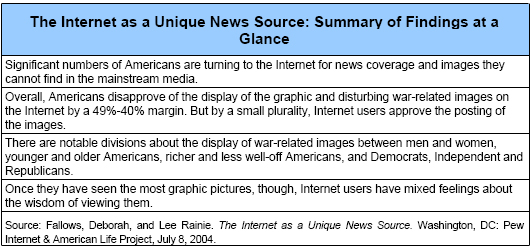Significant numbers of Americans are turning to the Internet for news coverage and images they cannot find in the mainstream media.
Over the last few months, war images have begun appearing online that were deemed too graphic and disturbing to be carried by the mainstream press. A significant number of Internet users, many of whom have explicitly gone looking for them, have seen these images online.
- 24% of adult Internet users have seen graphic war images online. That comes to more than 30 million people.
- 28% of those 30 million who have seen war images actively went looking for them.
The survey shows that 72% of America’s Internet users – or some 92 million people – have used the Internet to get news of any kind, not necessarily news related to the war. Furthermore, on any given day, about 27% of online Americans are gathering news on the Internet.
Overall, Americans disapprove of the display of the graphic and disturbing war-related images on the Internet by a 49%-40% margin. But by a small plurality, those who are Internet users approve the posting of the pictures.
As a whole, Americans show discomfort with the nature of the war images that are appearing on the Internet. By a 49%-40% margin, all Americans disapprove of the posting of such images. Another 4% said their views on the rightness or wrongness of displaying graphic pictures “depends” on the circumstances and images. And 7% refused to answer the question or said they didn’t know the answer.
However, a major cultural divide separates Internet users from non-users on this question. Internet users said by a small 47%-44% edge that they approved the display of the pictures. That is a sharp contrast with non-Internet users, who disapproved of the pictures by a 58%-29% margin.
There are notable divisions about the display of war-related images between men and women, younger and older Americans, richer and less well-off Americans, and Democrats, Independents and Republicans.
Other dramatic contrasts appear between segments of the population. And in some demographic groups, a scant majority of the members express approval of the graphic images being shown online; these include men, young Americans under 30 years old, high earners, and registered Democrats and Independents.
- 53% of men approve of the graphic war images being available online compared to 29% of women.
- 52% of those under 30-years-old approve compared to 44% of those 30 – 49 years and 31% of those over 50 years old.
- 52% of those with at least $50,000 income approve, compared to 35% of those with income less than $50,000.
- 52% of Democrats approve and 53% of Independents approve. That contrasts with the 42% of Republicans who approve.
Once they have seen the most graphic pictures, though, Internet users have mixed feelings about the wisdom of viewing them.
The horrific nature of many of the war-related images that have appeared online have left Internet users with a range of feelings.
- 51% of the 30 million Internet users who have seen the images felt they had made a good decision in looking at them.
- 33% of those who have seen the images wish they hadn’t seen them.
- 7% said they had both views.
Those who appear the most troubled by having seen the graphic and disturbing images include women, Americans under 50 years old, and those with lower socioeconomic status.
Those who felt they made a good decision to view the images online include:
- 68% of men compared 39% of women
- 69% of those over 50 years old compared to 54% of those 30 – 49 years and 56% of those 18 – 29 years old
- 65% of those with incomes over $50,000 per year compared to 49 % of those with incomes less than $50,000 per year
Those who wished they hadn’t seen the images include:
- 55% of women compared to 34% of men
- 48% of those 18 – 29 years old compared to 41% of those 30 – 49 years and 31% of those over 50 years
- 50% of those with incomes less than $50,000 per year compared to 33% of those with incomes over $50,000 per year





